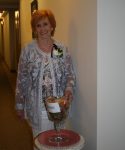Mt. Kisco Woman to Make Different Type of Donation After Death

There’s been much publicity and a growing understanding of the importance of becoming an organ donor to help save lives. Margaret Marcogliese has taken it an additional step.
Marcogliese, a Mount Kisco resident, recently decided that upon her death she will be donating her body to science, a relatively little-known option for people who will help teach the next generation of doctors and to assist on potential medical advances.
“I feel very special and I really think they’ll work on my body and they will help people,” she said. “I really feel that way.”
Earlier this year Marcogliese, a healthy and active 76-year-old, signed the forms to enroll in the whole body donation program at Albert Einstein College of Medicine in the Bronx. It is one of 18 medical schools and teaching hospitals throughout the state that comprise the Associated Medical Schools of New York (AMSNY), which participates in the program.
Although schools are located from one end of the state to the other, Marcogliese chose Albert Einstein since it is one of the closest New York City hospitals. It is required that a donor live within about 70 miles of the school where they choose to donate, said Anat Gerstein, an AMSNY spokesperson.
Marcogliese made the leap to donate her body after attending a TWIGS board meeting at Northern Westchester Hospital last year where President and CEO Joel Seligman spoke about the importance of organ donation. She said she had previously thought about donating her body, but wasn’t sure how to pursue it.
She reached out to the American Anatomical Society, which put her in touch with AMSNY. By February, Marcogliese had filled out and submitted the forms.
“They all thought I was nuts,” she said of her family. “But I’m really glad I did it.”
At first Marcogliese’s family may not have taken her seriously since she has been known to do a few offbeat things. Last year, for her 75th birthday, Marcogliese celebrated with family and friends by holding “a living wake.”
While the idea may sound macabre to many, her daughter, Deb Coffino, said cadavers are necessary tools.
“Schools really covet these bodies because they need them for their medical students,” Coffino said.
Gerstein said that in 2015, 192 people signed up with AMSNY to become donors. As of Aug. 5, there were 144 people to enroll this year, she said.
Most bodies may be used for medical study, however, there are some restrictions. For donors who have died of transmittable diseases, they may be rejected at the time of their death, Gerstein said. Those diseases include, but are not limited to, HIV, hepatitis, tuberculosis and septicemia.
People who have gangrene and jaundice cannot be taken, she said. There must also be no autopsy performed for a body to be accepted.
Gerstein said it is the best source for doctors and medical students to learn their profession.
“Throughout the history of medicine, the study of the human body has led to many major medical advances,” she said. “The human body is the first tool for doctors to learn medicine, and it remains one of the best. Most of today’s medical technology was made possible through research on the human body.”
According to AMSNY, anatomical study can last from one to three years. Once study of a body nears completion, the family of the deceased will be contacted to receive the cremated remains. Another option is for the school to bury the remains in graves owned by the institution.
Marcogliese said she will have a funeral Mass even if her body will be somewhere else. Coffino said with the escalating expense of funerals and burials and knowing you will be helping others, body donation may be appealing to some.
“To think about planning out a grave, a cemetery, how you want the funeral, the flowers, all that waste,” Coffino said. “Here she went from organ donation to take my body.”
To learn more about how to donate your body to science, contact AMSNY at 212-218-4610, e-mail juliato@amsny.org or visit www.amsny.org/initiatives/anatomical-donations.

Martin has more than 30 years experience covering local news in Westchester and Putnam counties, including a frequent focus on zoning and planning issues. He has been editor-in-chief of The Examiner since its inception in 2007. Read more from Martin’s editor-author bio here. Read Martin’s archived work here: https://www.theexaminernews.com/author/martin-wilbur2007/
